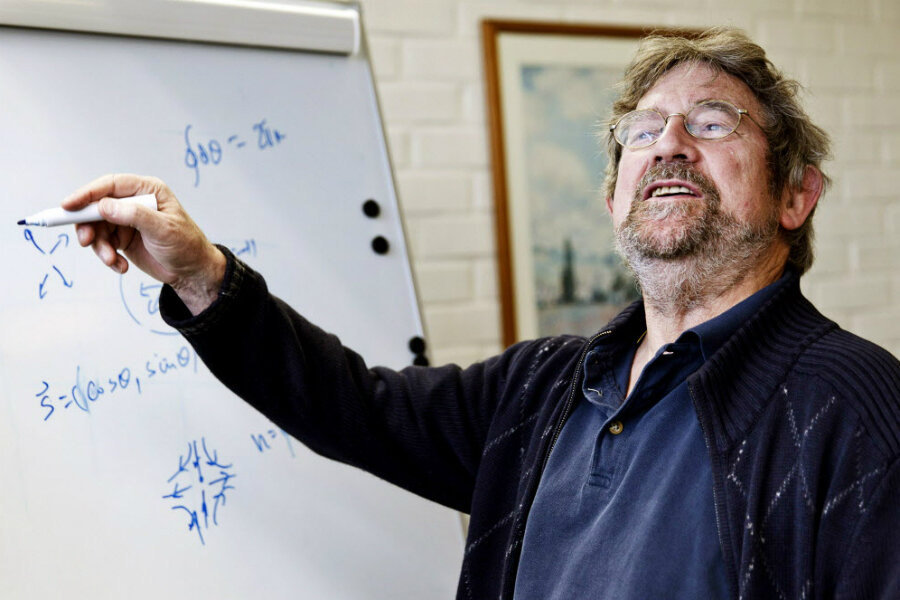Why 'strange' matter matters to the Nobel Prize committee
Loading...
On Tuesday, members of the Royal Swedish Academy of Sciences convened in Stockholm to present the Nobel Prize in Physics. The crowd favorite? MIT’s Laser Interferometer Gravitational-Wave Observatory (LIGO) collaboration, which identified gravitational waves from merging black holes, thus confirming Einstein’s theory of general relativity.
But LIGO didn’t take home the Nobel. Instead, the prize went to three British physicists working in a decidedly less flashy field of study: condensed-matter physics.
The winners – David Thouless, Duncan Haldane, and John Michael Kosterlitz – have spent much of their careers studying “strange” phases of matter. Using a branch of mathematics called topology, they demonstrated why these materials exhibit unusual properties. It’s important work, but Einstein and black holes are a winning combination in the court of public opinion. So why does matter, well, matter so much to the Nobel committee?
Topology refers to property changes that can only occur in whole steps. A piece of Swiss cheese, for example, can have any number of holes. But there’s no such thing as a half hole, so the measurement of holes in cheese can be only an integer.
This year’s laureates discovered that the properties of strange-matter materials can be measured the same way. In the 1970s, Dr. Kosterlitz and Dr. Thouless demonstrated that very thin materials, when cooled, could undergo “phase transition” to become superconductive. Just like the Swiss cheese, the electrical conductivity of the material would only change by integers.
Dr. Haldane applied the same concept to theoretical studies of magnetic atom chains.
“This matter is topologically different than regular matter, which means it can't be continuously changed,” Haldane said in a press conference. “This gives rise to some unexpected properties on the surface of these materials.”
When they were originally published, these studies were valued mostly for their theoretical input. But in recent years, practical uses have begun to emerge.
Quantum condensates can be created by super-cooling a material beyond its solid state. By creating controlled topological defects (i.e. “holes”) in these materials, researchers could induce certain quantum mechanical effects. Some experts say these and other material properties could lead to breakthroughs in quantum computing.
“This whole field has burgeoned, and this new way of thinking has led to even more discoveries,” Haldane said. “Whatever the future will bring ... we’ve gone a long way.”
Just how far? Let’s start at the beginning.
The idea of matter can be found deep within the annals of western philosophy. Hundreds of years before Socrates was born, ancient Greek philosophers toyed with the notion that everything is made of fundamental parts. Some postulated that water was the basic element found in every physical thing; Others believed that the distinction belonged to air or fire.
In the 5th century BC, Democritus argued that all materials consisted of tiny, indivisible particles called “atoms,” floating in a void. The philosophy of atomism may have actually originated a century earlier in the ancient Indian schools of materialism, but that debate has yet to be resolved. Despite sharing a name, these atoms weren’t much like the elemental particles we know today – they came in an infinite number of shapes and sizes and had no internal structure.
Aristotle later argued that matter, or “hyle,” was directly related to change. In his view, matter was an underlying principle, rather than a physical substance. Imagine eating an apple: After you’ve finished chowing down, your body will retain the apple. But not the whole fruit – just some aspect of it, the part that Aristotle called matter. This may seem obvious now, but it was a revolutionary concept at the time.
Nearly 2,000 years later, René Descartes and Isaac Newton began to assign mathematical concepts, such as inertia and gravity, to the physical properties of matter. This set off a new surge of scientific discovery. In 1897, J.J. Thompson discovered the first subatomic particle: the electron. Physicists later identified new phases of matter – superfluids, condensates, Quantum Hall states, photonic matter, and more – beyond the fundamental solids, liquids, gases, and plasmas.
Quantum mechanics, the set of rules which govern the entire universe on the subatomic scale, emerged a few years later. And that’s where the story of three British physicists really begins.









